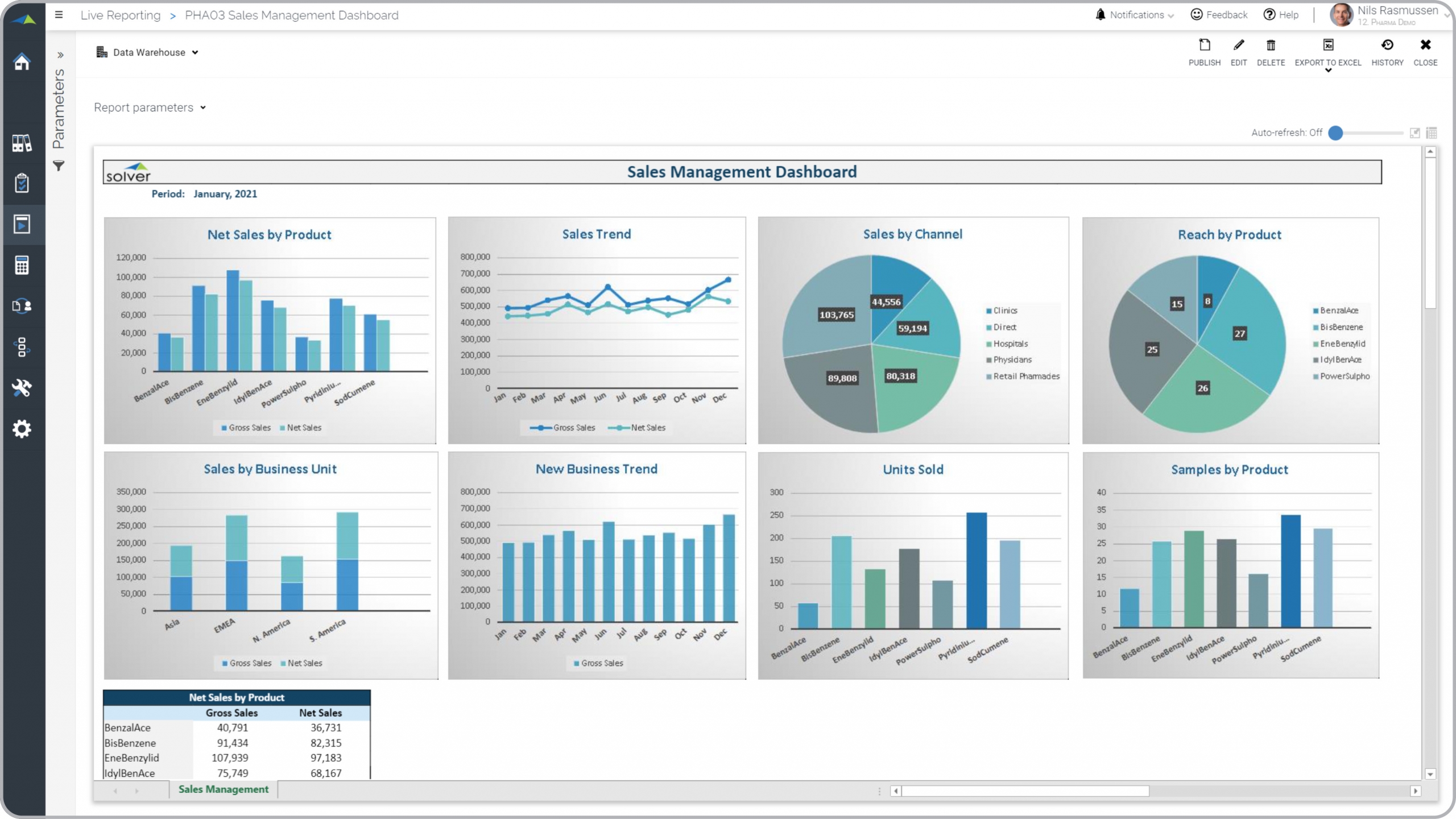Sales Dashboard for Pharmaceutical Companies
What is
a
Sales Dashboard for Pharmaceutical Companies
? Sales Dashboards are considered revenue analysis tools and are used by sales managers and executives to compare sales performance and monitor monthly trends. Some of the main functionality in this type of report is that it provides analysis from eight different perspectives, including: 1) Products rankes by Net Sales and compared to Gross Sales, 2) Monthly trend for Net Sales and Gross Sales, 3) Sales compared by channel, 4) Reach by product, 5) Gross Sales and Net Sales by business unit, 6) Monthly trend in Gross Sales, 7) Product ranked by units sold, and 8) Samples given by product. You find an example of this type of report below.
Purpose of
Sales Dashboards Pharmaceutical companies use Sales Dashboards to provide sales leaders with an easy way to track product performance. When used as part of good business practices in sales and Financial Planning & Analysis (FP&A) departments, a company can improve its revenue strategies and it can reduce the chances that managers react slow to sales issues because of lack of information.
Example of a
Sales Dashboard Here is an example of a Sales Dashboard with comparisons and monthly trends. [caption id="" align="alignnone" width="2560"]
 Example of a Sales Dashboard for Pharmaceutical Companies[/caption] You can find hundreds of additional examples
here
Who Uses This Type of
Report
? The typical users of this type of report are: Executives, Sales Leaders.
Other Reports Often Used in Conjunction with
Sales Dashboards Progressive sales and Financial Planning & Analysis (FP&A) departments sometimes use several different Sales Dashboards, along with sales forecasts, annual budgets, detailed sales reports, profit & loss reports and other management and control tools.
Where Does the Data for Analysis Originate From? The Actual (historical transactions) data typically comes from enterprise resource planning (ERP) systems like: Microsoft Dynamics 365 (D365) Finance, Microsoft Dynamics 365 Business Central (D365 BC), Microsoft Dynamics AX, Microsoft Dynamics NAV, Microsoft Dynamics GP, Microsoft Dynamics SL, Sage Intacct, Sage 100, Sage 300, Sage 500, Sage X3, SAP Business One, SAP ByDesign, Acumatica, Netsuite and others. In analyses where budgets or forecasts are used, the planning data most often originates from in-house Excel spreadsheet models or from professional corporate performance management (CPM/EPM) solutions.
What Tools are Typically used for Reporting, Planning and Dashboards? Examples of business software used with the data and ERPs mentioned above are:
Example of a Sales Dashboard for Pharmaceutical Companies[/caption] You can find hundreds of additional examples
here
Who Uses This Type of
Report
? The typical users of this type of report are: Executives, Sales Leaders.
Other Reports Often Used in Conjunction with
Sales Dashboards Progressive sales and Financial Planning & Analysis (FP&A) departments sometimes use several different Sales Dashboards, along with sales forecasts, annual budgets, detailed sales reports, profit & loss reports and other management and control tools.
Where Does the Data for Analysis Originate From? The Actual (historical transactions) data typically comes from enterprise resource planning (ERP) systems like: Microsoft Dynamics 365 (D365) Finance, Microsoft Dynamics 365 Business Central (D365 BC), Microsoft Dynamics AX, Microsoft Dynamics NAV, Microsoft Dynamics GP, Microsoft Dynamics SL, Sage Intacct, Sage 100, Sage 300, Sage 500, Sage X3, SAP Business One, SAP ByDesign, Acumatica, Netsuite and others. In analyses where budgets or forecasts are used, the planning data most often originates from in-house Excel spreadsheet models or from professional corporate performance management (CPM/EPM) solutions.
What Tools are Typically used for Reporting, Planning and Dashboards? Examples of business software used with the data and ERPs mentioned above are:
- Native ERP report writers and query tools
- Spreadsheets (for example Microsoft Excel)
- Corporate Performance Management (CPM) tools (for example Solver)
- Dashboards (for example Microsoft Power BI and Tableau)
Corporate Performance Management (CPM) Cloud Solutions and More Examples
July 28, 2021
TAGS:
Reporting,
Solver,
report writer,
Microsoft,
template,
practice,
Acumatica,
Netsuite,
Finance,
planning,
GP,
dashboard,
pharmaceutical,
Business Central,
excel,
ax,
forecast,
Budget,
Dynamics 365,
budgeting,
KPI,
Cloud,
Software,
Tableau,
SAP,
example,
best,
Sage,
BC,
D365,
NAV,
Intacct,
pharma,
project,
CPM,
report,
SL,
Management,
dynamics,
sales,
Power BI,
sales manager,
drug,
products,
business unit,
channels,
producers,
payers

